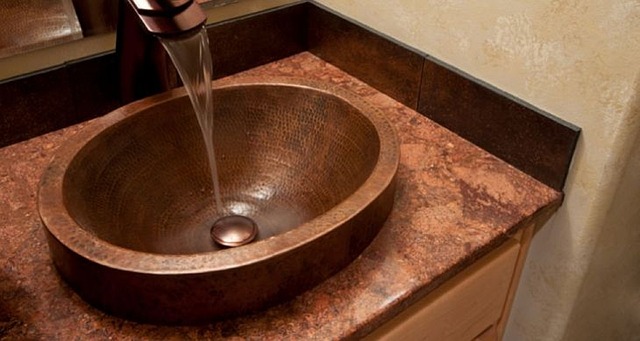By using wrong solutions or allowing grime and crud to build up will degrade the patina of your sink. Knowing how to clean a copper sink gives you a tried-and-true method for removing even the most stubborn tarnish, water stains, and mineral deposits.
Copper sinks and faucets are perfect for the home. Your gleaming copper sink and fixtures will stay gleaming and ready to take whatever you throw at them if you give them frequent upkeep and follow a good plan.
Table of Contents
Copper Sink Maintenance Guidelines
1. Clean with warm water, light dish soap, and a soft cloth or sponge after each use, but avoid using harsh or abrasive chemicals or cleansers.
2. Never use steel wool, scouring pads, or any other firm scrubbing pad.
3. To remove a tough stain from your sink’s surface, use baking soda with warm water.
4. To avoid mineral deposits and green stains, dry your sink thoroughly after each use.
5. To avoid temporary discoloration and scratches on the sink’s surface, always remove food debris (particularly acidic foods) and dishes.
6. To protect and shine your copper sink’s finish, use a copper protectant or wax like Sinkology’s Copper Armor once a month. That concludes the procedure.
Copper sinks also have a patina, which is a protective layer. This living finish is found naturally in copper and provides antimicrobial qualities that vary and evolve over time. Discoloration is unavoidable with copper because it is a living metal. Copper sinks have a beautiful aesthetic, a long lifespan, and are naturally antimicrobial. So, whether you want to keep your sink looking polished or prefer a natural look, a little regular maintenance will keep it looking great day after day.
Use Dish Soap
When it comes to cleaning copper, there’s no need to grab for the harsh chemical cleaners right away. Copper and comparable metal sinks are difficult customers that perform well when cleaned with liquid dish detergent and water the majority of the time. To cope with common stains and other problems, use mild dish soap.
Use a Damp Sponge for Daily Treatments
Knowing how to clean a copper sink entails more than just knowing how to clean copper in a complex, advanced way. When there’s no awful mess, set-in areas, or uneven patina, simple solutions work best. In many cases, warm water, a sponge, and a little elbow grease will take care of most of the work and keep the buildup at bay. Best of all, no additional chemicals are added to the mix with this procedure. Put on your gloves and soak your sponge in hot water. Wipe the sink down from top to bottom, scouring any spots that need extra care with a moderate scrubbing motion. To avoid more water marks or other discolorations, dry all surfaces when you’ve finished with the sponge.
Using a Copper Cleaner to Reduce Aging and Stains
Your DIY efforts have prevented a lot of the tarnish and buildup from affecting the appearance of your copper sink, but home cures may only go so far. Regular treatments with a commercial copper cleaner are part of an effective game plan for keeping copper sinks looking attractive. In the fight against dingy, tarnished metal, a copper cleaner is a must-have. When using copper cleaning, use gloves and any other necessary protective equipment, such as breathing and eye protection. Allow for sufficient ventilation by opening windows. Follow the manufacturer’s instructions so that you can get help if you need it. To avoid future problems, rinse the copper surfaces and dry them with a towel or cloth after cleaning.
Apply a Sealant
The battle against stains and tarnish on your copper sink and faucets can feel endless when cleaning them. Copper has a natural patina that develops over time. After cleaning the copper, apply a sealant layer to protect it from darkening and staining. After a decent stain removal session, a food-safe wax or lacquer is all that’s needed to keep the copper’s mellow sheen. Commercial copper protectants and lacquers are available at your local home improvement store, and carnauba wax is also effective on the surfaces of your sink. Apply the wax or other sealant using a gentle and clean cloth, and then buff it to a high sheen.
Baking soda is a good way to clean a copper sink
To remove stains, make a paste by combining baking soda and a few drops of water. Scrub it into the stain using a sponge. This paste can also be used to remove green patches on copper known as verdigris. After you’ve removed the discoloration with the paste, thoroughly rinse the sink and dry it.
How is ketchup used to clean copper?
Copper oxidizes when exposed to air, giving it a tarnished appearance. Copper oxide dissolves in ketchup when mixed with a weak acid and table salt. Spread the ketchup all over your copper-bottomed pans and keep it on as long as you can. Wipe and rinse after that.
How do you clean a copper sink the best way possible?
Warm water, mild dish soap, and a soft sponge should be used to scrub copper sinks. Apply a copper cleaning and wax at least once every six weeks to keep your polished sink looking good.
Use vinegar on copper sinks
A solution of half cup white vinegar and half cup water can be used to remove stubborn stains or filth from your sink. Remove the filth or discoloration using a cloth dipped in the solution. To avoid causing harm to your sink’s finish, rinse it off and dry it afterward.
Bleach will damage a copper sink
The copper surface is also corroded when bleach is used. While copper has a high resistance to corrosion, bleach speeds up the process and can harm copper pipes and fittings.


